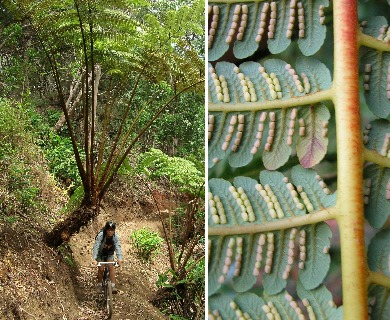Hāpuʻu Pulu
Cibotium glaucum
Manfern family (Cibotiaceae)
Native species ()
This treefern is widespread in wet forests and is the most common species on the island of Hawaii. It is distinguished by the smooth leaf-stalks with masses of shiny golden brown, soft hairlike on the enlarged base and lower part. Also, the leaf branches (pinnules) are stalkless, the leaf segments divided to and beneath whitish and hairless, and the lowest pair of leaf segments common with earlike and overlapping the axis.

©2005 Forest And Kim Starr
Leaves () several, erect and spreading, the oldest dying and bending down along the trunk, very large, feathery, divided three times (), mostly 6–8 ft (1.8–2.4 ) long. Leafstalk or axis () stout, slightly flattened, the enlarged base with masses of shiny golden brown hairlike to 2 inches (5 ) long, beyond light green and hairless. The main axis bears many pairs of branches () to 2 1⁄2 ft (0.8 ) long, further divided. Branches (pinnules) many pairs, narrowly lance-shaped, 5–6 inches (13–15 ) long and 1⁄2–3⁄4 inch (13–20 ) wide, stalkless, divided to Segments many, nearly paired, long, narrow, rounded, slightly curved, to 3⁄8 inch (10 ) long and less than 3⁄16 inch (5 ) wide, with edges turned under and slightly wavy, thin, upper surface slightly shiny green with fine side veins slightly sunken, lower surface whitish and hairless.
Older leaf segments bear, on lower surface at ends of veins and on edges, two rows of seven or fewer yellowish boxlike cups (indusia) more than 1⁄32 inch (1 ) wide, each containing masses of dark brown cases (), which shed masses of microscopic abundantly.
The main product of this treefern was pulu, the dense soft cover of glossy, of hairs at the base of young coiled leaves. Pulu served the Hawaiians as an absorbent surgical dressing and in embalming the dead. This “wool” was harvested, often by cutting down the larger plants, and exported mainly to California for stuffing mattresses and pillows. According to Degener (1930), the harvest was extensive by 1859, rose to the maximum export of almost 623,000 pounds in 1869, and ended by 1885. Because it becomes matted, breaks into powder, and absorbs moisture, pulu was replaced by other fibers. About 1920, treeferns were cut for the starch in their trunks, which was used for laundry and cooking. However, that industry was short-lived.
Widespread but apparently uncommon in wet forests at low and middle altitudes of 800–6000 ft (244–1829 ).
Special area
Volcanoes
Range
Larger Hawaiian Islands except Maui
This species propagates by trunk buds as well as It grows well in shady, damp gardens at sea level and is often used as an ornamental. The other species do not survive at sea level.



